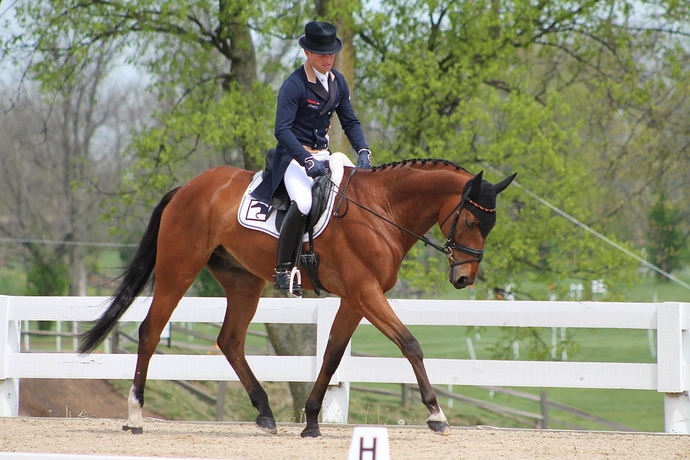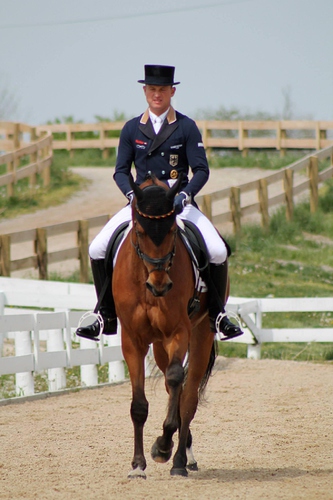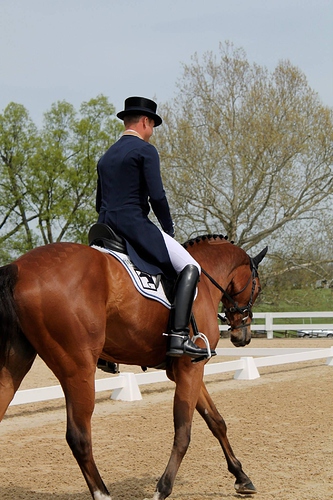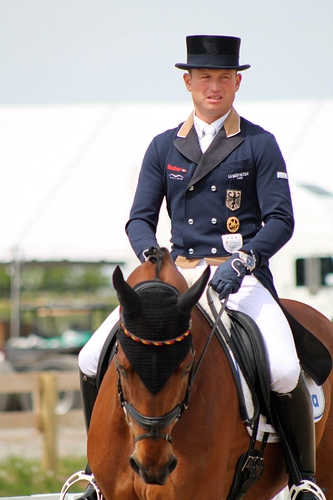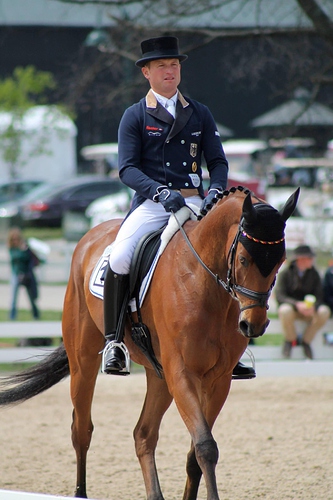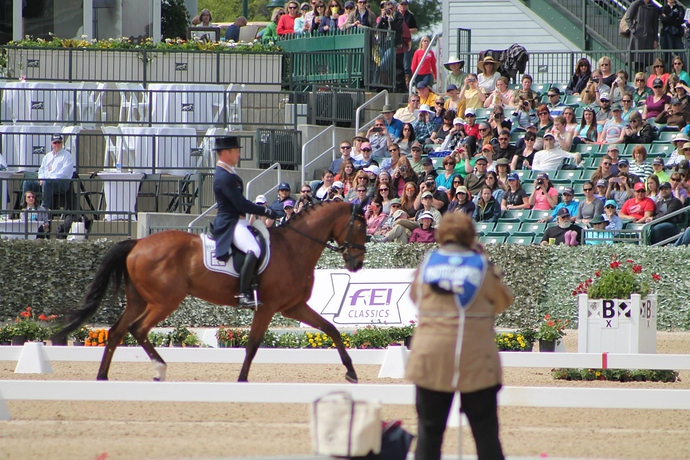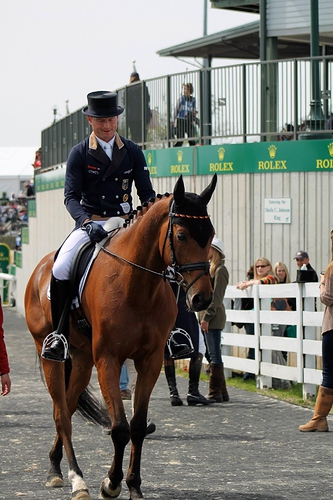Personally the 7pp for a flag knocked concerns me much much more about the direction of the sport.
That’s a good point. My memory is not great, I just remembered them having 40s scores.
That’s valid too, but I don’t think one issue detracts from the other problem being a problem too.
I was listening to a webinar that Lucinda Green did with Chris Bartle and Richard Waygood yesterday, and one comment that was made was that if you look at a lot of Michael Jung’s dressage scores, it’s frequently a whole pile of 7-7.5 with an 8 thrown in here or there. He gets low scores by being consistent. I remember watching Kentucky coverage in 2015/16/17 and hearing the commentators repeatedly say that Roxy wasn’t fancy but he rode her so correctly and harmoniously that it didn’t matter (although I’d be hard-pressed to say Roxy isn’t fancy, but not flashy certainly).
Richard also commented that using the dressage training scale can be a useful tool to figure out what’s going wrong when you’re having issues with XC. What part of the training scale are you failing to properly perform when something goes wrong? Is the horse not in a good rhythm? Are you riding a 2x4 that can’t/won’t bend? Are they evading the contact? Are they not straight? Once you figure out what level the issue is on, what are you going to do about it? Try to drill it over fences, or take apart all the pieces to figure it out on the flat and then over poles before you put the jumps back up?
Personally I have no problem with 45 as the MER score rather than 50, but I also have no plans to run anything above Training in my life because I’m not sure my brain will agree with the bigger fences, so there’s a very real possibility that I’ll never have to contend with this. All the same, I don’t think I’d want to move up if I couldn’t consistently demonstrate a sub-45 dressage score. XC is my favorite and my (extremely green) horse seems to have a natural inclination toward it, but I’m not going to sit here and say that our last five lessons drilling bend and transitions and lateral work haven’t made a complete difference in both his rideability and his self-carriage (again, he’s super green, marginal gains are extremely noticeable right now), which I’m sure will translate over when we make it back out on a XC course again.
(I am also in a barn where my trainer spent the last couple of years in her time between upper-level mounts getting her USDF bronze medal on a 1.40m jumper turned dressage superstar, so I am perhaps biased.)
I personally disagree with all of the above. However, I agree with so many of the posters here (@subk, @beowulf, @trubandloki, and others) that I haven’t had much to add until now.
Here’s a fun case study: Cornelia Dorr. She KNOWS how to ride a great test. She holds dressage records with her young rider horse, Louis M. We are not talking about a lack of rider understanding. Her current horse is Daytona Beach 8. This horse was produced through 3* by Sandra Auffarth (a World Champion). We are not talking about a lack of horse understanding. The horse is beautifully bred, and a lovely mover, but she is also h.o.t. She has multiples scores at 4 and 5 star above 45, and at least one above 50, in the past two years. She also has pulled a sum total of three rails in that period (across nine rounds), and just ran double jumping clear to finish 10th at Burghley.
Daytona Beach 8 is not poorly trained. Her rider is not poorly educated. They put in excellent jumping performances and are not a safety risk. Even with a poor dressage score (they sat 50th out of a field of 52 at Burghley) they have plenty of “hope” of being competitive. The horse is an out-and-out event horse, and punishing her because she struggles mentally in the sandbox just has no helpful impact on the sport.
Sam Watson speaks frequently about one of the biggest issues facing our sport: people buying fancy, flashy dressage horses and hoping they can jam them around an xc track. People are buying horses without enough blood, and we are seeing accidents because of it. Equiratings has made many proposals (ex. the Z Line) to decrease the influence of dressage on eventing in the name of safety. I fail to see why moving in the opposite direction is helpful. I agree with this:
Louis M’s record (NB: she rode him before the dressage coefficient was removed): https://data.fei.org/Horse/Performance.aspx?p=EF9534DCAD4D1EBD78BBF2A231D8AF2E
Daytona Beach 8’s record: https://data.fei.org/Horse/Performance.aspx?p=DF5C9FC3CAAFDC5A5ABD912F147E5E6B
I will say, @Jealoushe, on this we do agree:
High scorer here. Typically not above 45. But I remember one day that my mare and I put down a super accurate, willing and responsive novice test at rocking horse. She didn’t put a foot wrong and I was incredibly proud. I watched countless other riders with disobedience bc it was a chilly January.
My mare scored a 44. The worst of the day. The judge (whom I talked to all week) came to tell me after “your mare starts at a 5 for me because she is incredibly downhill and shows her teeth. I know it’s just the way she is, because you are a lovely rider and she is very willing. But you will always struggle to break 40 on her”
She went on to put the best stadium, and a phenomenal cross country, where we were slow, because I was confirming ridability for a move up. I show jumped around that novice course and she was foot perfect for every fence. The next novice out she got to work on speed.
I have always said I could care less about a high score in dressage if the horse is SAFE cross country. Does it suck when you train and work your butt off and you get immediately down played bc your horse grins, or sticks their tongue out, or is downhill and a shitty mover? I always go for accuracy, but I have fully given up on ever being competitive with that horse in the lower levels. And that is fine. When and if I ever move up, I am still going to look for the safe and brave cross country horse over the good mover. Because I get nervous and I want to live 
I’m not trying to be a jerk, but the examples given of you and your mare (the teeth showing must be more than just a grin with an otherwise quiet mouth to have that be the #1 contributing factor towards a 44), or the one 5* rider that struggles to get sub 40, are outliers.
The results don’t lie. They’re easily found on USEA’s website. I wish there was an easy way to export them to excel, because that would make them much easier to analyze.
You were given other examples of 5 star riders who do not score low in the dressage, but jump around well. I can name more if you would like. I was discussing a single example of a 5 star combination who does not score low, jumps around well, and is competitive, in answer to your argument of “you have literally no hope of being competitive in any way, shape, or form” and to point out that there are plenty of reasons to “take on the other risks associated with XC” even if you didn’t start sub-30.
It’s not relevant if they are an outlier. A horse who can get you a top-10 finish at Burghley (especially with a rider under the age of 25) is a horse most riders would walk through fire for. There are simply not very many of them on this earth - in that way, they are all outliers of a sort. Those horses should not be excluded from the sport, particularly when there is absolutely no safety-related reason to do so. If horses with that profile were statistically more likely to flip over and injure the 25 year old, absolutely, restrict them. But they aren’t. Which horses are far more likely to do that? The dressage bred horse that scored in the teens that someone is hoping will make it over all the solid obstacles in one piece. As far as I’m concerned, we need to wait until we’ve solved that problem before we worry about avoiding the judgement from the dressage world.
It wasn’t. It was also the shitty movement and the downhill, but I may even still have the video. I’m not saying we don’t have work to do, but I am saying in certain areas, a bad mover with one other vice, will score a 44.
Sara Gumbiner is another example of a horse with poor dressage scores and a great xc record fwiw.
Exactly this.
I don’t care one bit about placing. If I was to ever move past training, my number one factor is a safe and sound horse over xc.
Enjoying the COMPLETELY observational data discussion here.
In the past, using real statistical methods, there has been shown NO statistical corellation between dressage score and XC injury or death. See the FEI epidemiological study in 2016.
EXCEL can’t actually do the statistics needed to justify your claims, @endlessclimb. You need PCA with multivariate methods. If you have those already built in EXCEL, then I need to chat with you because I have some MASSIVE databases that need that.
The driving force behind the change in score for dressage is actually to push the training aspect on the riders. It forces them to do more work with better training as one moves up the levels. On can no longer simply go full “backyard” and ignore dressage.
Similarly, my friends 2* mare was consistently high scoring. She was built downhill and he natural carriage was on the forehand. She developed neck arthritis as she moved up the levels and I imagine, in part, it was because it was abnormal for her to carry herself that way. She is a lovely type, though. Through and has schoolmaster like buttons. They were able to stay competitive in dressage by riding very accurate tests. She was a beast on cross country and only pulled a rail if you got in her way. Many UL riders agreed that she had the ability to go Advanced, but there would be a lot of additional pressure with the new MERs.
As an AA with one horse, I do fear it will prevent me from moving up and it will be unneccesary wear and tear on my horse, but I’ll take 6 over 10. I do think that as a blanket rule 6 is fair. IMO there are more people rushing to move their horses up than not. I imagine the rules were written with them in mind. it only takes one flame to start a fire…
Sure it can. We aren’t talking about earth shattering analysis here, RAyers. We want to see if someone with a shitty 45/50+ dressage score can complete XC with few to no faults, more often than not.
From a brief glance over the last year’s results, the answer is no.
We aren’t talking about historical injury or death on this particular thread. That data isn’t available to us anyways because the USEA keeps that under wraps.
Nope. You are oversimplifying the group interactions. Things such as weather, rider, venue, fence type,… all have a bearing on a fall and thus there is NO direct correlation between dressage and XC penalties without first considering interactions. Many important variables can affect dressage scores as well that have no bearing on XC.
If you can only assume there is direct connection, then you automatically bias the observations and statistics to match you bias.
Hence the necessity of Principle Component Analysis to figure out the variables that actually affect the parameter you want to study.
Yes exactly! And seeing Sam in person at Rolex in the warm up close I can say he is not fancy, he’s downhill and he isn’t a big mover. But he was untouchable.
Photos of said occasion just because I love Mj
That sounds like a bad judge. If your horse is truly relaxing into the contact and forward and meeting all the objectives listed on the top of the test for that level you should be scoring 6s.
5* is kind of moot for this discussion because there is no higher level where a MER would be required. Doesn’t apply to the 5* level at all.
Agreed. This is a great discussion btw.
Where we aren’t connecting is that you are talking about falls specifically.
I am not.
I was speaking generally - did they complete without penalty, or not.
Just out of curiosity, I looked up a random local BE event running multiple sections of BE 100. This is the largest cohort of British Eventers, so mainly amateurs running one horse. A quick glance at the results in just three sections, some 90 horses completing, showed only one rider that had a score over 40 (40.8). The vast majority were in the 30s, a few were in the 20s. There were very few “finished on dressage score” and they were the winners. In this entirely unscientific sample, the majority of the jumping faults were on the XC rather than SJ
I’m old enough to remember when a score of 40 would win a competition and scores of 60 and 70s were fairly common. Now, people train in all three phases and being good in two will not win. It is just how the sport has evolved.
MERs are setting a minimum standard to move up a to a higher level. MERs have nothing to do with being competitive in the level you’ve been running in for years.
And, to win consistently on a dressage score, learn to make the time xc. An adjustable, supple, straight and obedient horse saves loads of time. Dressage, anyone?
Off topic but mute point here referring to Louis M as a “young horse” she set records with. It was a horse already well established and setting records on the flat at the advanced level before she got it. In Cornelias situation, it was a horse that taught her to ride dressage. And she is lovely!

